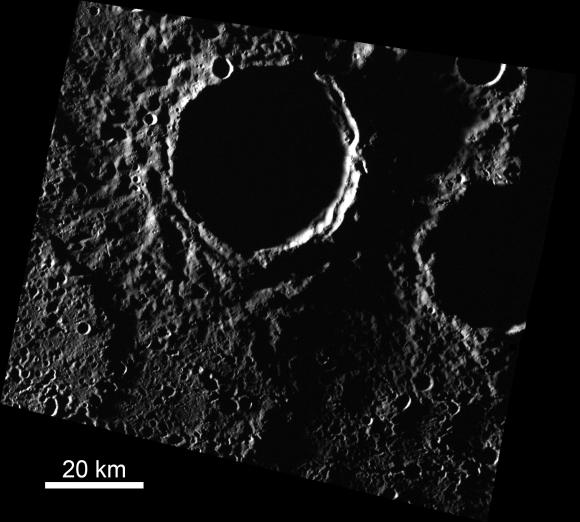
The scorching hot surface of Mercury – the closest planet to the sun – seems like an unlikely place to find ice, but research over the past three decades has suggested that frozen water hidden away on crater floors that are permanently shadowed from the sun’s blistering rays. Now, a new study led by Brown University researchers suggests that there could be much more ice on Mercury’s surface than previously thought.
The study, by researchers from Brown University, published September 14, 2017 in Geophysical Research Letters, adds three new members to the list of craters near Mercury’s north pole that appear to harbor large surface ice deposits. The researchers estimate the total area of the three sheets to be about 3,400 square kilometers (1,313 square miles) — that’s slightly larger than the U.S. state of Rhode Island.
In addition to those large deposits, the research also shows evidence that smaller-scale deposits scattered around Mercury’s north pole, both inside craters and in shadowed terrain between craters. Those deposits may be small, but they could add up to a lot more previously unaccounted-for ice.
The idea that Mercury might have frozen water emerged in the 1990s, when Earth-based radar telescopes detected highly reflective regions inside several craters near the planet’s poles. Mercury’s axis doesn’t have much tilt, so its poles get little direct sunlight, and the floors of some craters get no direct sunlight at all. Scientists calculated that because Mercury doesn’t have an atmosphere to hold in any heat from surrounding surfaces, temperatures in those eternal shadows are low enough for stable water ice. That raised the possibility these “radar-bright” regions could be ice.
That idea got a boost after NASA’s MESSENGER probe entered Mercury’s orbit in 2011. The spacecraft detected neutron signals from the planet’s north pole that were consistent with water ice. For this new study, the researchers looked more deeply into the MESSENGER data.
How this polar ice may have found its way to Mercury in the first place remains an open question. The leading hypothesis is that it was delivered by water-rich comet or asteroid impacts. Another idea is that hydrogen may have been implanted in the surface by solar wind, later combining with an oxygen source to form water.
Enjoying EarthSky so far? Sign up for our free daily newsletter today!
Donate to EarthSky: Your support means the world to us
Bottom line: A new study by scientists at Brown University identifies three large ice sheets at Mercury’s poles.











